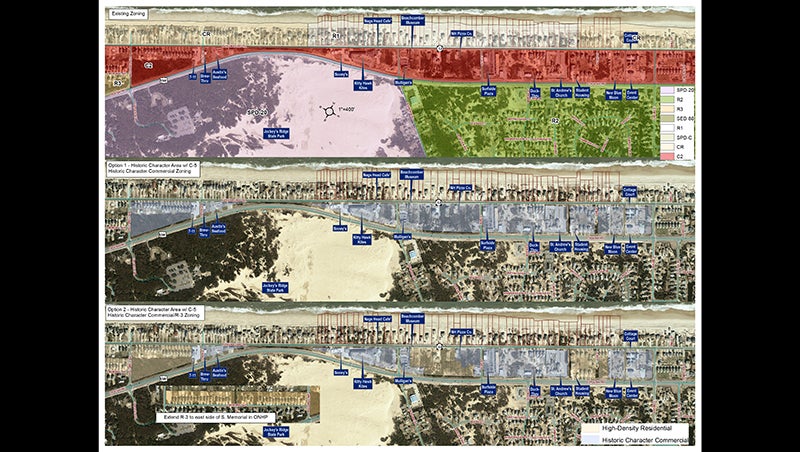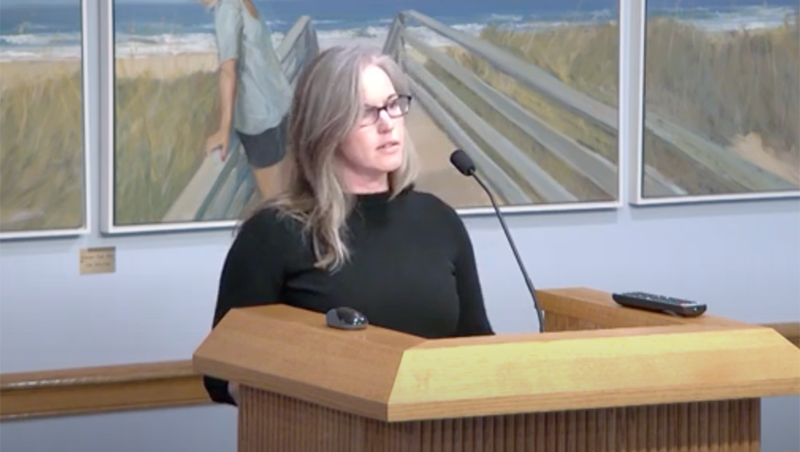Nags Head considers rezoning part of C-2 district
Published 12:09 pm Thursday, February 9, 2023
|
Getting your Trinity Audio player ready...
|
Nags Head is considering major zoning changes to a portion of its C-2, General Commercial District, from East Hollowell Avenue to Danube Street, or the commercial part of the Historic Character Area.
At the February 1 commissioners meeting, planning director Kelly Wyatt introduced a new zoning proposal that would create an entirely new district – the Historic Character Commercial District (C-5) – and rezone other sections as R-3, High Density Residential.
This comes as welcome news to some property owners who own homes in the area, and a shock to others who are facing a possible downzoning of their commercial properties.
There has been a building moratorium in place since October 19 to allow the town time to examine current uses, and make sure they are consistent with town’s goals of protecting the Historic Character Area, which, according to the 2017 Comprehensive Plan, includes homes and businesses in Historic Cottage Row, Jockey’s Ridge, Soundside Road and surrounding areas.
Zoning changes moved to the top of the town’s priorities after a vacant 4.7-acre parcel on Hollowell Avenue and Hwy 158 was selected by Woda Cooper developers for a 54-unit multi-family housing project, which was an allowable use when the application was submitted. Several who own property in proximity to the proposed development spoke up to commissioners in opposition to the project.
At the January 4 meeting, commissioners voted to remove “multi-family dwelling” as an allowable use in C-2. Shortly after, Woda Cooper withdrew its appeal to the Nags Head Board of Adjustment challenging the denial of their application, saying that the issue was now “moot” after the board eliminated the possibility of multi-family housing at the Hollowell site.
Wyatt presented to commissioners on February 1 the planning department’s zoning change recommendations in the C-2 portion of the Historic Character Area.
The planning board considered two options – rezoning the entire C-2 portion in the Historic Character Area to C-5; or hand-selecting the rezoning of the Historic Character Area to either C-5 or R-3, High Density Residential.
Out of two options, the planning board opted to recommend to commissioners the second – a combination of C-5 and R-3. This was the most restrictive option of the three the planning board discussed and reduces the permitted uses in the district. It is unclear at this point what criteria was used to determine a C-5 or R-3 designation for each parcel. The Town of Nags Head did not respond to requests for comment before the publication deadline.
In the areas designated R-3, uses would be limited to mostly single family and two-family homes, and some other structures like parks, government buildings, beach accesses and churches. Wyatt said that in conversation with residents of the Historic Character Area, most people preferred a downzoning to residential. R-3 is recommended to be extended past Hollowell Avenue to the east side of S. Memorial Avenue in Old Nags Head Place.
Also slated for residential zoning is the 4.7-acre parcel on Hollowell Street.
In the areas designated C-5, the proposed language in the Unified Development Ordinance says the district is “intended to accommodate small, neighborhood scale, pedestrian oriented commercial and residential development patterns” and will encourage the development of “unique, locally owned businesses designed to be reflective of the community’s heritage and lifestyle both in scale and massing as well as site layout.”
The ordinance says that appropriate uses for C-5 include single-family dwellings (5,000 sq. ft. or less), office, retail, take-out, walk-up and sit-down restaurants, galleries, cottage courts and churches.
Uses that are currently permitted in C-2 that would not be allowed in C-5 include, among others, convenience stores, pharmacies, furniture stores, plant nurseries, hardware stores, banking institutions, dry cleaners, funeral homes, indoor fitness/gyms, indoor public assembly facilities, parking lots, shoe repair shops, tutoring/learning centers, building contractor’s office, town-operated farmer’s markets, non-profit/community outreach centers and theaters.
Uses that may be allowed but require additional permits are grocery stores, retail shops, bookstores, candy stores, bakeries, community gardens, libraries, museums, professional offices, restaurants, coffee shops, spas, tailors, massage therapy services, group fitness facilities like dance and yoga, hair salons and pet grooming retail shops.
Aside from allowed housing, most additional uses or changes must go through an approval process so the town can carefully regulate what businesses and changes would be allowed.
“It does change the timeline for a change of use. It could change the timeline for a lot of things, but given the nature of the area we thought that it was going to be a good idea to allow that extra time,” Wyatt said.
Several residents shared their approval of these suggested zoning changes during the public comment portion of the meeting.
“It’s quite clear to me that over the years the Board of Commissioners has put a lot of time and planning into the comprehensive land use plan and I encourage you all to continue to follow that spirit,” said property owner Michael Mischou, who recently retired in Virginia and now lives full-time in Nags Head.
Not all property owners were happy with the proposed changes.
Nags Head real estate broker Bobby Harrell read a letter to commissioners on behalf of Elliot Katherman, the owner of the 4.7-acre parcel on Hollowell Street, objecting to the proposed downzoning of his property from commercial to residential for “non fact-based reasons.”
“What’s the rationale for singling out my property and not including this commercially zoned 4.6 acres into C1 or the proposed C5 historic designation? A well-planned village of shops, cafes, etc., certainly would add more to the historic character look of the neighborhood and help the Town of Nags Head much more than 15 more cookie cutter rental machines.”
“Think about it – for 20 plus years you’ve invested in your property and now you want to retire … What happens to your current property value? I think we all know what will happen to our property value … Where’s the sense of basic fairness in this proposed rezoning of my property?” Katherman’s letter asked.
In an email to The Coastland Times, Harrell said that downzoning is not a standard practice for town government when a permitted use is planned.
Harrell said that while Katherman could apply to have his property subdivided, he stands to lose a lot of money if this zoning proposal goes through.
“The value, especially of this undeveloped commercial site will be reduced considerably, plus hundreds of thousands will need to be spent on infrastructure prior to selling lots,” Harrell said.
Harrell said single family residential on the bypass is “always discounted” due to location and traffic noise. “This site has 1000′ of bypass frontage,” he added.
Commissioners approved a public hearing for March 1 to receive input from the public before making a final decision.
SUBSCRIBE TO THE COASTLAND TIMES TODAY!








